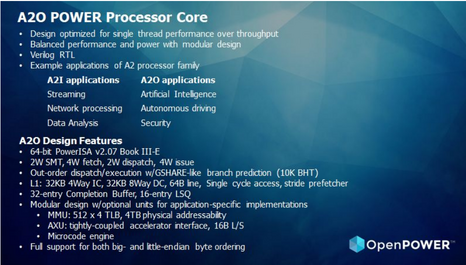 Today at OpenPOWER Summit 2020, IBM announced it is contributing two technologies to the OpenPOWER community: the A2O Power processor core, an “out-of-order” follow-up to the A2I core and associated FPGA environment; and Open Cognitive Environment (Open-CE), based on IBM’s PowerAI, designed to enable improved consumability of AI and deep learning frameworks
Today at OpenPOWER Summit 2020, IBM announced it is contributing two technologies to the OpenPOWER community: the A2O Power processor core, an “out-of-order” follow-up to the A2I core and associated FPGA environment; and Open Cognitive Environment (Open-CE), based on IBM’s PowerAI, designed to enable improved consumability of AI and deep learning frameworks
The contributions follow the open sourcing of the Power ISA and associated reference designs in August 2019 and the A2I POWER processor core in June 2020, according to the company.
IBM said the A2O Power processor core is a multi-threaded, 64-bit POWER ISA core developed as a processor for customization and embedded use in system-on-chip (SoC) devices. It’s most suitable for single-thread performance optimization. A follow-up to its parent, the high streaming throughput A2I predecessor, it maintains the same modular design approach and fabric structure. The Auxiliary Execution Unit (AXU) is tightly coupled to the core, intended for special-purpose designs for new markets tackling the challenges of modern workloads.
The A2O core is available on GitHub at: https://github.com/openpower-cores/a20
Open-CE, based on IBM’s PowerAI project (released as IBM Watson Machine Learning Community Edition), is designed to make foundational AI and deep learning frameworks, libraries and tools, such as TensorFlow and PyTorch, more accessible. Open-CE is a source-to-image project that provides a pre-integrated, multi-architectural set of recipes, build scripts, pre-defined kubernetes-native continuous integration pipeline code and models for building packages and container images for AI development.
Also at the conference, OpenPOWER member Oregon State University (OSU) also announced an intent to build and offer community binaries related to each tagged release of Open-CE in an effort to grow participation in the project and in the open source AI community. Community binaries will be offered through a conda channel for multiple architectures, including powerpc little endian, both with and without Nvidia CUDA support.

OSU said it is committed to supporting open source software. At the OSU Open Source Lab, for example, researchers develop AI-based tools to answer scientific questions and challenges. Many of the research groups leverage multiple architectures to complete their work, and multi-architecture tools like PowerAI allow them to focus on research rather than software.
“We leverage PowerAI for all of our main AI tools across different architectures,” said Christopher Sullivan, Assistant Director for Biocomputing at OSU’s Center for Genome Research and Biocomputing. “These packages are optimized to take advantage of architecture-specific capabilities and other generalized package sets cannot provide. We see a
huge benefit in making this a community-managed resource under the new name Open-CE.”
Open-CE is available on GitHub at: https://github.com/open-ce
Allan Cantle, CEO of Nallasway and recently appointed Technical Director and Board Advisor of OpenCAPI Consortium also spoke at OpenPOWER Summit 2020. Cantle previously held positions as CTO of the ISI group within Molex and CEO and Founder of Nallatech. He also has experience with OpenPOWER Foundation as a member of the Board of Directors and Chair of the OpenPOWER Accelerator workgroup from 2016 – 2018.
“OpenCAPI is a clear leader with its ultra low latency implementation together with the complimentary Open Memory Interface (OMI),” said Cantle during his keynote. “OMI provides best in class memory bandwidth, together with depth, at the lowest possible cost when compared directly with native DDR4 DIMM and HBM Memories.”
Cantle said OMI has a bandwidth advantage of 4x over DDR4 and 1.2x over HBM2 as well as a DRAM Depth advantage of 2.3x over DDR4 and 116x over HBMs, while only adding <10ns latency over standard RDIMMs.




